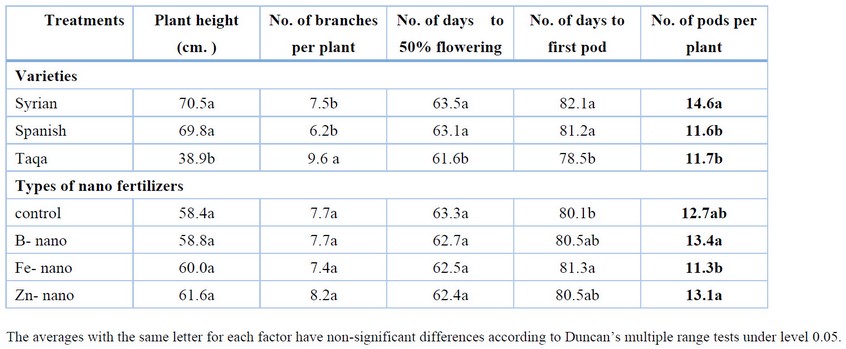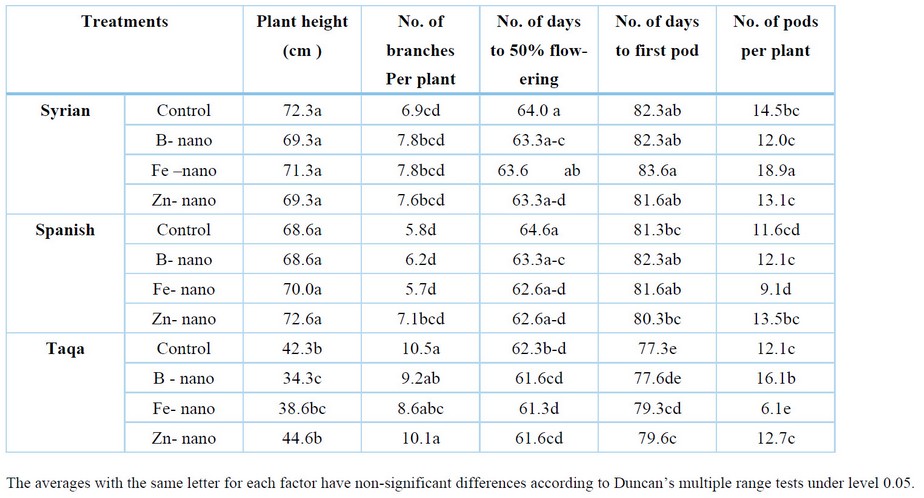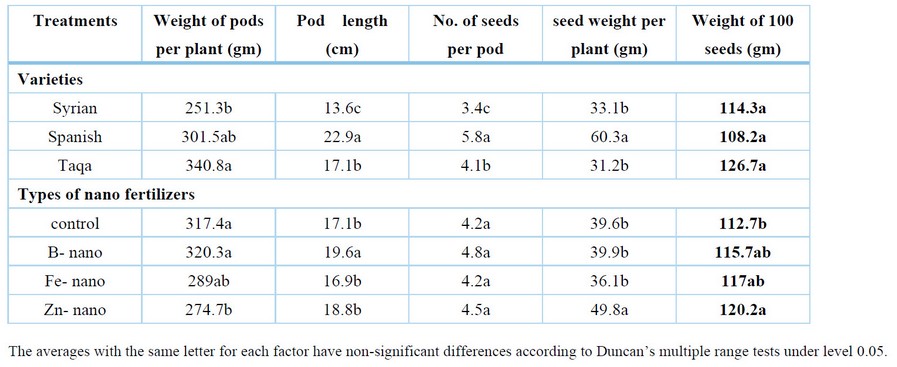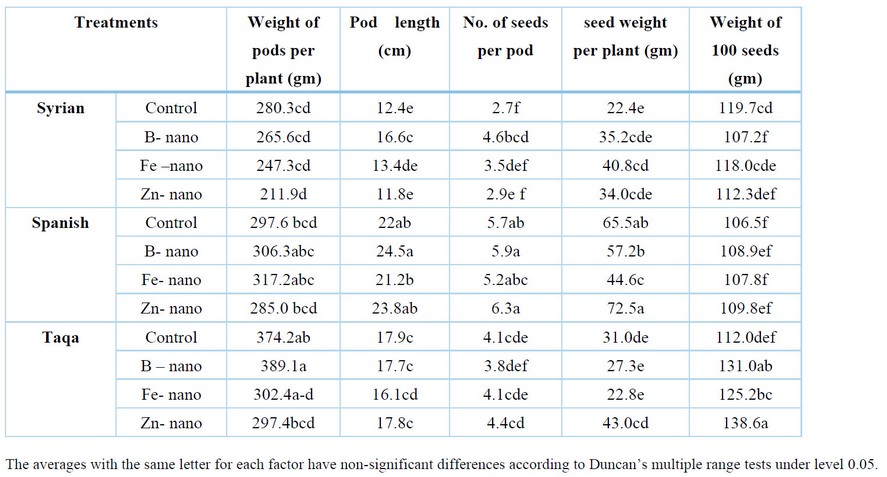2022.07.04.37
Files > Volume 7 > Vol 7 No 4 2022
Response of three broad bean varieties ( Vicia faba L.) to boron, iron, and zinc nano fertilizers
Ahmed Alabade1 , Safwan. Al-Khashab2 , Abdelmonnem Kahlel3 *
1,2Agricultural Research, Ministry of Science &Technology, Iraq
3 Plant Production Department, Technical Agricultural College Northern Technical University, Mosul, Iraq
*Correspondence author: [email protected]
Available from: http://dx.doi.org/10.21931/RB/2022.07.04.37
ABSTRACT
This work was carried out at the Research Station of the Seed Technology Center of the Agricultural Department / Ministry of Science and Technology during the season 2020-2021 to investigate the effect of three nano fertilizers ( boron, iron, zinc) at a rate of 2 mg. l-1 on three wide been varieties (Syrian, Spanish, Taqa). The experiment was carried out in a randomized complete block design (R. C. B. D.) with three replicates. The results showed that the Syrian variety gave the highest values of plant height and number of pods per plant, while the Spanish type gave the highest values of pod length, number of seeds per pod and seed weight per plant. Taqa variety recorded the highest number of branches, plant and total seed yield weight of 100 seeds, the lowest number of days to 50% flowering and the first pod formation. Nano fertilizers increased some growth and yield properties. B-nano fertilizer gave the highest values of the number of pods per plant, pods weight per plant, pod length and the number of seeds per pod, while Zn- nano fertilizer increased plant height, plant and total seeds yield.
Keywords: broad been, pods, yield, seeds, nano fertilizers.
INTRODUCTION
Faba bean (Vicia faba L. ) is a winter-growing food legume crop, growing for three main reasons as a component of a rotation based on winter or summer cereals or cotton, green manure where soils have been degraded in organic and physical fertility. And cash crops through marketing dry seeds.
Many studies on faba bean show significant differences among varieties concerning yield and yield components1,2. Growing three faba bean cultivars (Nubaria 1, Nubaria 2 and Nubaria 3 ), they found that Nubaria 2 recorded the highest value of plant height (cm), pod length (cm), number of pods/plant, number of seeds/pod, 100- seed weight (g), grain, straw, and biological yield (tons/fed.)3.
In a study to evaluate three faba bean cultivars (Reina, Giza and Local), the results showed that the Reina cultivar significantly increased (No. of branches, Pod Yield g. plant-1, Total Yield ton. Donum-1, No. of seed per pod, no. of seed. Plant-1, seed weight (g), seed, yield.plant-1 total seed yield ton. donum-1 and weight of 100 seed g). While the Giza cultivar significantly increased (plant high, pod length cm, pod weight g.)4. A study to evaluate three faba bean varieties (Gora, Moti and Degaga) found that the highest seed yield was from Degaga, Moti and Gora varieties, respectively5.
Nanotechnology can present solutions for increasing the value of agricultural products and reducing environmental problems. Using Nano-particles and nanopowders can be delayed releasing fertilizers. Nanoparticles have high reactivity because of more specific surface area, more density of the reactive regions, or increased reactivity of these areas on the particle surfaces. The Nano fertilization technique depends on minimizing bulk materials to get at least one dimension smaller than 100 nm6.
The use of nano fertilizers causes an increase in their efficiency, reduces soil toxicity, minimizes the potential adverse effects associated with overdosage and reduces the frequency of application. Nano fertilizers mainly delay the release of nutrients and extend the fertilizer effect period. Hence, nanotechnology has a high potential for sustainable agriculture, especially in developing countries7. In a study of the effect of nanomaterial on faba bean, the results indicated that zinc nanomaterials (50ppm) caused a significant increase in overall bean length, number of branches, and number of branches compared with sulfur concentrations and the control 8. Spraying faba bean plants with iron as iron nano oxide (Fe3O4), 150 mg Fe L-1, and 300 mg Fe L-1 showed the highest plant height, the number of pods per plant, and seed yield by the high nano-Fe 300 followed by 150 and 300 mg Fe L-1 (as Fe-EDTA) respectively9. Studied the response of faba planted to the foliar spray of ZnO NPs concentrations (0, 50, and 100 mg L-1), while an enhancement was recorded in response to foliar treatment with ZnO NPs at 50 and 100 mg L-1. The highest amounts of chlorophyll a, b, carotenoids, and total pigments were recorded in plants that received 50 mg L-1 ZnO NPs compared to the alternative control. Secondary metabolites (phenols, flavonoids, and tannins) were accumulated in response to ZnO NPs treatment was noticed10. This study investigates the effect of three nano fertilizers (Fe, B and Zinc) on the growth and yield of three faba bean varieties.
MATERIALS AND METHODS
This study was carried out at the Research Station of Seed Technology Center of the Agricultural Department of Science and Technology Ministry during the season 2020-2021 to investigate the effect of spraying three types of nano-fertilizers (boron, iron, zinc) on growth and yield of three varieties of broad bean (Syrian, Spanish, Taqa) at a concentration of 2 g L-1.
The experiment was carried out using a randomized complete block design (R. C. B. D.), and each treatment was repeated three times.
Studied traits: plant height (cm), Number of branches/plant, Number of days until 50% flowering, The number of days for the appearance of the first pod, Number of pods/plant, Weight of pods/plant (gm), Pod length (cm), Number of seeds/pod, Weight of seeds/plant (gm) and Weight of 100 seeds (gm)
The results were statistically analyzed according to the statistical analysis system (SAS) and compared with the means by the Duncan multiple range test at 0.05 level11.
RESULTS
Data in table (1) revealed the effect of foliar spraying of nano fertilizers in the vegetative growth of three broad bean varieties. It was found that the Syrian variety gave the highest Plant height ( 70.5 cm), number of days to 50% flowering (63.5 days), number of days to first pod (82.1 days), and number of pods/plant (14.6). Meanwhile, the highest number of branches per plant ( 9.6) was from the Taqa variety. Also, table 1 showed that spraying with nano fertilizers increased the vegetative growth parameters, the highest plant height ( 61.6 cm), and the number of branches per plant (8.2). The number of pods/plant (13.1 ) was from spraying with Zn- nano fertilizer, while the highest number of days to 50% flower (63.5 days), number of days to first pod (81.3 days) was from spraying Fe- nano fertilizer.

Table 1 . Effect of foliar spraying of nano fertilizers in vegetative growth of three broad bean varieties.
Table 2 showed that combination treatments between varieties and nano fertilizers significantly affected the vegetative growth parameters.The highest plant height (72.6 cm) was obtained from a combination treatment between the Spanish type and Zn nano fertilizer. At the same time, the highest number of branches per plant ( 10.5) was from a combination treatment between the Taqa variety and control. The combination treatment between the Spanish variety and control gave the highest number of days to 50% flowering (64.6 days ). Moreover, the highest value of the number of days to the first pod (83.6 days ) and the number of pods per plant ( 18.9 pods ) was recorded from a combination treatment between the Syrian variety and Fe –nano fertilizer.

Table 2. Effect of combination treatment between varieties and nano fertilizers in vegetative growth of three broad bean varieties.
Table (3) result illustrates the effect of foliar spray of nano fertilizers in yield components of three broad bean varieties. It was found that the Taga variety gave the highest weight of pods/plant (340.8 gm) and weight of 100 seeds (126.7 gm). While the Spanish variety recorded the most increased pod length (22.9 cm), the number of seeds per pod (5.8 ), and seed weight per plant (60.3 gm).
Table 3 also showed that spraying nano fertilizers increased the yield component of broad bean, B- nano fertilizer recorded the highest weight of pods/plant (320.3 gm), pod length (19.6 cm), and the number of seeds per pod (4.8 ). While Zn- nano fertilizer recorded the highest seed weight/plant (49.8 gm) and weight of 100 seeds (120.2 gm).

Table 3. Effect of foliar spraying of nano fertilizers in yield component of three broad bean varieties.
Table 4 illustrates the effect of combination treatments between varieties and nano fertilizers in yield components. It was found that combination treatment between the Taqa variety and B – nano obtained the highest value of the weight of pods per plant (389.1 gm), in regards to pod length (cm), the highest value (24.5 cm) recorded from combination treatment between Spanish variety and B-nano. At the same time, the highest value of the number of seeds per pod (6.3 ) and seed weight per plant (72.5 gm) was recorded from a combination treatment between the Spanish variety and Zn-nano fertilizer. The combination treatment between the Taqa variety and Zn-nano fertilizer recorded the highest weight value of 100 seeds (138.6 gm).

Table 4 . Effect of combination treatment between varieties and nano fertilizers in yield component of three broad bean varieties.
DISCUSSION
Increasing vegetative growth among varsities can be attributed to their genetic differentiation, which may allow higher plant capacity to absorb more nutrients from the soil, more photosynthetic surfaces, and, therefore, better photosynthetic capacity12,13. The significant increase in growth and yield of broad bean plants due to the application of micronutrients and micronutrients might be attributed to improvement in growth parameters and yield attributes. The product of a plant is an outcome of improvement in growth-attributing parameters. The improved growth and yield components observed in the present investigation might be due to higher uptake of nutrients due to an enhanced supply of nutrients with addition primarily through foliar application. The adequate supply of all essential nutrients might have helped improve photosynthesis and translocation of photosynthates from source to sink.
Vegetative growth enhancement may be due to the role of nano micronutrient stimulatory effects on the production of chlorophyll, photosynthesis, mitochondrial respiration, and hormone biosynthesis14. The positive impact of foliar spraying of zinc nano-fertilizer on vegetative growth parameters comes along with results reported on snap bean plants15. This could be explained by the fact that the foliar application of micronutrients has led to an increase in vegetative growth, consequently, higher production capacity, which is reflected in the quality. These results are in accordance3 on faba bean. As one of the essential micronutrients, zinc is involved in many vital physiological processes, such as hormone biosynthesis (auxin, abscisic acid, gibberellin and cytokinin), chlorophyll synthesis, chloroplast development, protection and maintenance of the stability of the cell membrane structure. It is also a cofactor of many enzymes associated with transferases, hydrolases, ligases and isomerases that regulate the ionic balance and stomatal conduction when different nanoparticles pass through the roots by the apoplastic pathway and are transported in the shoots through the vascular system16.
CONCLUSION
From this study, it can be concluded that the Syrian variety gave the highest values of plant height and number of pods per plant, while the Spanish variety gave the highest values of pod length, number of seeds per pod and seed weight per plant. B-nano fertilizer gave the highest importance for the number of pods per plant, pods weight per plant, pod length and the number of seeds per pod, while Zn- nano fertilizer increased plant height, plant and whole grains yield.
Author Contributions: Conceptualization Abdelmonnem, methodology, Ahmed; software, Safwan; validation, Abdelmonnem and Safwan, formal analysis, Ahmed; investigation, Abdelmonnem; resources, Safwan; writing—original draft preparation, Ahmed and Safwan and Abdelmonnem, writing—review and editing, Safwan and Abdelmonnem; visualization, Ahmed: project administration, Abdelmonnem, All authors have read and agreed to the published version of the manuscript.
Funding: self-funding
Conflicts of Interest: there is no conflict.
REFERENCES
1. Derya, OY Optimal Intra-Row Spacing For Production Of Local Faba Bean (Vicia faba L. MAJOR) Cultivars in the Mediterranean Conditions. Pak. J. Bot., 2016.45(6): 1933-1938.
2. Kuber, T.E.; C.V. Raghavaiah and I. Hamza. Production Potential of Faba Bean (Vicia faba L.) Genotypes in Relation to Plant Densities and Phosphorus Nutrition on Vertisols of Central Highlands of West Showa Zone, Ethiopia, East Africa. Adv. Crop Sci .Tech.2016. 4: 214. doi:10.4172/2329-8863.1000214.
3. Gomaa. M.A., Kandil E.E, AbuoZeid A.A,and Bilkees M.A.S . Response of some faba bean varieties to fertilizers manufactured by nanotechnology. J Advan Agric. Res.2016. 21(3):384–399
4. Ali, .S. T.2019 . Effete of Cultivars , Plant spacing and AL-Gamix on Growth an Green yield of Broad Bean (Vicia faba L.) Journal of University of Duhok. (Agri. and Vet. Sciences). 2016.22(1): 204-220.
5. Dereje ,D., W. Worku ., D. Bekela, Z. Mulatu, F. Shimeles, and A. Admasu. The response of Faba bean (Vicia faba L.) varieties as evaluated by varied plant population densities in the highlands of Arsi Zone, Southeastern Ethiopia.2019.
6. Montalvo,D.,McLaughlin,M.J.,andDegryse,F.Efficacy of hydroxyapatite nanoparticles as phosphorus fertilizers in Andisols and Oxisols. Soil Sci. Soc. Am. J.2015. 79:551–558.
7. Naderi, M. R. and A. Danesh-Shahraki. Nano fertilizers and their roles in sustainable agriculture. Int. J. Agri. Crop Sci.2013. 5 (19): 2229-2232.
8. Kahlel, A,S. Ghidan A, Al-Antary T.A., Alshomali I, and Asoufi H. . Effects of nanotechnology liquid fertilizers on certain vegetative growth of broad bean (Vicia faba L.). Fresen Environ Bull.2020. 29:4763–4768
9. Abdel-Salam, M. A. Implications of Applying Nano-Hydroxyapatite and Nano-Iron Oxide on Faba Bean (Vicia faba L.) Productivity. J.Soil Sci. and Agric. Eng., Mansoura Univ.2018. 9 (11): 543–548.
10. Mogazy, A.M. and R.S. Hanafy .Foliar Spray of Biosynthesized Zinc Oxide Nanoparticles Alleviate Salinity Stress Effect on Vicia faba Plants. Journal of Soil Science and Plant Nutrition.2022. https://doi.org/10.1007/s42729-022-00833-9.
11. Al-Rawy, K.M. and Khalaf-Allah, A.M. Design and Analysis of agricultural Experiments. Foundation of Dar Al-Ktab. Univ. Mosul, Min. High. Educ. Sci. Res., Iraq.2000. 488
12. Salwa M, Hanan L, Nora M. Physiological and biochemical responses of two cultivars of Phaseolus vulgaris L. to application of organic fertilizers and Nile compost in sandy soil. Am. J. Exp. Agric. .2013.3(4):698–717.
13. Said S, Guangmin L, Mingchi L, Yanhai J, Hongjuand H. and Nazim G. Effect of irrigation on growth, yield, and chemical composition of two green bean cultivars. J Hortic.2018. http://www.mdpi.com/journal/horticulturae
14. Hänsch R., and Mendel R . Physiological functions of mineral micronutrients (Cu,Zn, Mn, Fe, Ni, Mo,B, Cl). Curr. Opin. Plant Biol.2009. 12(3):259–266.
15. Nahla M. M., A. S. Shams, M. A. Abdel-Salam. Zinc foliar spray on snap beans using nano-Zn with N-soil application using mineral, organic and biofertilizer. Middle East Journal of Agriculture Research. 2019. 6 (4) :1301-1312.
16. Sturikova H., Krystofova O., Huska D, and Adama V. Zinc, zinc nanoparticles and plants. J. Hazard Mater.2018. 349:101–110.
Received: August 25, 2022 / Accepted: October 12, 2022 / Published:15 November 2022
Citation: Alabade A, Al-Khashab S, Kahlel A. Response of three broad bean varieties ( Vicia faba L.) to boron, iron, zinc nano fertilizers. Revis Bionat a 2022;7(4) 37. http://dx.doi.org/10.21931/RB/2022.07.04.37
